10
Dec
The impact of Covid on the dental profession: prevention and data on the diffusion of Covid in dental practices
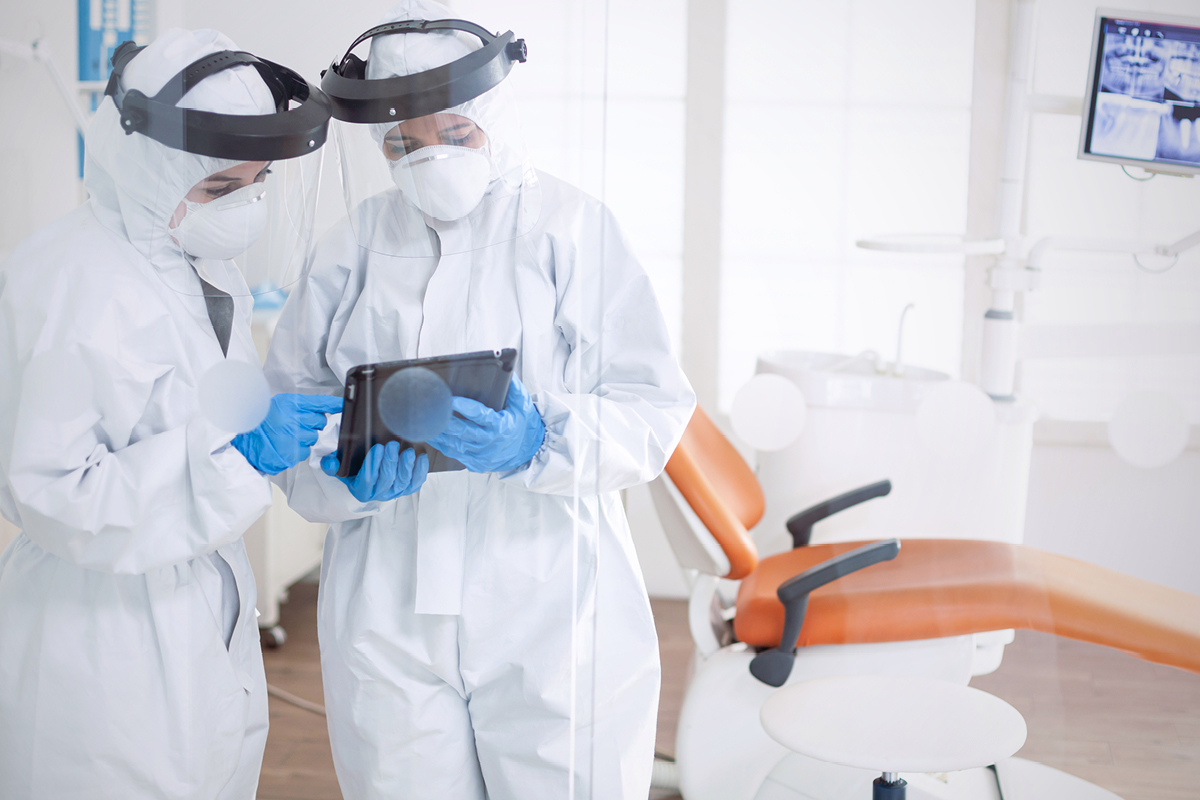
The worldwide diffusion of the SARS-CoV-2 virus caused a global scale public health emergency and, on 11 March 2020, forced the World Health Organisation (WHO) to declare a pandemic [1].
Research into the COVID-19 pathogen has shown that person-to-person transmission of the virus occurs largely through droplets of saliva or nasal fluids (droplets), or as a result of direct contact with materials infected by oral, nasal and ocular mucous [2,3]. Since SARS-CoV-2 exists in bodily fluids (saliva/blood), even indirect contact with contaminated surfaces or instruments can be a major source of infection [4,5]. Dental practices, therefore, immediately became classified at high risk of transmission given the nature of the procedures involved.
Because dental treatments have to performed in close proximity to the patient’s mouth, they inevitably expose dental professionals to an elevated risk of infection [6]. Airborne transmission is also highly likely given that many of the instruments commonly used in clinical operations, including ultrasonic scalers, syringes and high-speed handpieces, generate aerosols during functioning. One study has shown that the Covid-19 virus can remain alive in aerosols even after 3 hours in suspension [7].
Restrictions and operative indications for dentists
In the spring of 2020, these circumstances led to the imposition of various restrictions on dentists with a view to lowering the risk of infection. Non-urgent appointments had to be re-scheduled and dentists were obliged to accept only urgent cases in which delay would have been damaging to the patient, and even then had to adopt all due precautions [8].
Even in the absence of specific guidelines early in the crisis, dentists tried their best to prevent the spread of the virus in their surgeries (where only urgent cases were being treated) by first screening patients by phone for symptoms associated with COVID-19, and then explaining that to enter the practice, patients needed an appointment and had to wear a face mask and disinfect their hands [9]. By measures such as these it was hoped to reduce the number of patients in the surgery at any one time and, if this proved impossible, to ensure proper social distancing between those present. Waiting rooms were also emptied of all magazines and unnecessary items that could not be properly disinfected [10,11].
After this early phase, which lasted from March to May 2020, the Italian authorities published new operating procedures that dentists had to follow in Phase 2 of the Covid-19 pandemic [12]. This document clearly laid down the clinical procedures and minimum safety standards that dental surgeries needed to respect in order to minimise the risk transmission. It was established that since every patient had to be considered as potentially contagious, it was essential not to operate below the specified standards, or the safety of the patient and of practice staff could not be guaranteed [12].
A new way of working
By adapting to this new way of working, dentists were able to return to normal clinical operations. They soon got used to wearing FFP2 and FFP3 face masks for all procedures that could produce aerosols and further strengthened the already strict standards of hygiene, disinfection and sanitisation in force. Working environments were re-organised to make the disinfection and sterilisation of instrument as easy as possible, and to increase the use of disposable products instead of ones that required sterilisation before re-use.
The results of this effort were visible almost immediately: after 8 months of pandemic, a Spanish report comparing the rates of Covid infections in healthcare personnel showed that risk was lower for dental practitioners than any other segment of the healthcare sector, especially doctors and nurses [13]. This finding is certainly reassuring; it is also highly significant since dental professionals were previously classed among those most at risk of Covid. The results of this research can at least partly be explained by the fact that in recent years, dentists had already put in place protocols to protect patients against other viruses (like HIV), had improved equipment sterilisation and hand disinfection procedures, and had standardised the use of PPE. These actions alone very probably enabled dentists to operate on patients with a high level of safety [13].
In addition, another study published in BMC Health Services Research demonstrated how the protocols used by hygienists in dental practices effectively reduce the spread of Covid-19, both among patients and dental personnel [14]. The results of this research also showed that dental hygienists in Italy had adjusted their working habits to suit the level of professional risk connected with the pandemic and were properly prepared to face the risk of infection by the SARS-CoV-2 virus. The research confirmed that the measures adopted by hygienists proved effective in preventing contagion [14].
These findings corroborate those of an INAIL report published on 21 October, based in data to 30 September 2020, stating that “no serious cases of Covid-19 have occurred among dental practice employees” [15]. Similar findings have been reported by the ADA (American Dental Association), which published the results of a survey of a large number of American dental practitioners, showing that the rate of contagion in the dental sector was below 1% [16].
Conclusions
These statistics encourage us to consider dental practices and surgeries as extremely safe places, in which anti-contagion procedures (disinfection, sterilisation, sanitisation, etc.) are rigorously implemented, and where treatments are performed with maximum safety for patient and staff. To conclude, the pandemic has further strengthened dentists’ reputation for prevention, and is making them the reference point for all other branches of the medical profession [15,17].
References:
[1] Coronaviridae Study Group of the International Committee on Taxonomy of Viruses. The species Severe acute respiratory syndrome-related coronavirus: classifying 2019-nCoV and naming it SARS-CoV-2. Nat Microbiol 2020;5:536–44. https://doi.org/10.1038/s41564-020-0695-z.
[2] Ge H, Wang X, Yuan X, Xiao G, Wang C, Deng T, et al. The epidemiology and clinical information about COVID-19. Eur J Clin Microbiol Infect Dis 2020;39:1011–9. https://doi.org/10.1007/s10096-020-03874-z.
[3] Peng X, Xu X, Li Y, Cheng L, Zhou X, Ren B. Transmission routes of 2019-nCoV and controls in dental practice. Int J Oral Sci 2020;12:9. https://doi.org/10.1038/s41368-020-0075-9.
[4] Laheij AMGA, Kistler JO, Belibasakis GN, Välimaa H, de Soet JJ, European Oral Microbiology Workshop (EOMW) 2011. Healthcare-associated viral and bacterial infections in dentistry. Journal of Oral Microbiology 2012;4:17659. https://doi.org/10.3402/jom.v4i0.17659.
[5] Azzi L, Carcano G, Gianfagna F, Grossi P, Gasperina DD, Genoni A, et al. Saliva is a reliable tool to detect SARS-CoV-2. Journal of Infection 2020;81:e45–50. https://doi.org/10.1016/j.jinf.2020.04.005.
[6] Checchi V, Bellini P, Bencivenni D, Consolo U. COVID-19 Dentistry-Related Aspects: A Literature Overview. International Dental Journal 2021;71:21–6. https://doi.org/10.1111/idj.12601.
[7] van Doremalen N, Bushmaker T, Morris DH, Holbrook MG, Gamble A, Williamson BN, et al. Aerosol and Surface Stability of SARS-CoV-2 as Compared with SARS-CoV-1. N Engl J Med 2020;382:1564–7. https://doi.org/10.1056/NEJMc2004973.
[8] https://www.odmeo.re.it/public/uploads/2020/03/COMUNICATO-ANDICAO.pdf n.d. n.d.
[9] Ayyed AB. Dental Practice Infection Control Measurements: Coronavirus Disease (COVID-19) Outbreaks. Int J Clin Pediatr Dent 2020;13:279–83. https://doi.org/10.5005/jp-journals-10005-1770.
[10] Odeh ND, Babkair H, Abu-Hammad S, Borzangy S, Abu-Hammad A, Abu-Hammad O. COVID-19: Present and Future Challenges for Dental Practice. Int J Environ Res Public Health 2020;17:E3151. https://doi.org/10.3390/ijerph17093151.
[11] Banakar M, Bagheri Lankarani K, Jafarpour D, Moayedi S, Banakar MH, MohammadSadeghi A. COVID-19 transmission risk and protective protocols in dentistry: a systematic review. BMC Oral Health 2020;20:275. https://doi.org/10.1186/s12903-020-01270-9.
[12] https://www.salute.gov.it/imgs/C_17_pubblicazioni_2917_allegato.pdf n.d.
[13] https://consejodentistas.es/pdf/coronavirus/ANALISIS_RIESGO_Y_PREVALENCIA_COVID_EN_PERSONAL_SANITARIO.pdf n.d.
[14] Bontà G, Campus G, Cagetti MG. COVID-19 pandemic and dental hygienists in Italy: a questionnaire survey. BMC Health Serv Res 2020;20:994. https://doi.org/10.1186/s12913-020-05842-x.
[15] http://www.quotidianosanita.it/lavoro-e-professioni/articolo.php?articolo_id=89346 n.d.
[16] Estrich CG, Mikkelsen M, Morrissey R, Geisinger ML, Ioannidou E, Vujicic M, et al. Estimating COVID-19 prevalence and infection control practices among US dentists. The Journal of the American Dental Association 2020;151:815–24. https://doi.org/10.1016/j.adaj.2020.09.005.
[17] https://www.andi.it/report-inail-31-agosto-2020-nessuna-denuncia-per-covid-19-tra-le-aso/ n.d.
Do you want more information on Zhermack Dental products and solutions?
Contact us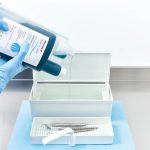
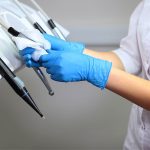
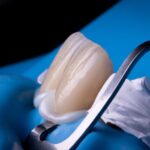
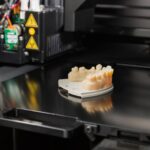

 Zhermack SpA has been one of the most important producers and international distributors of alginates, gypsums and silicone compounds for the dental sector for over 40 years. It has also developed solutions for the industrial and wellbeing sectors.
Zhermack SpA - Via Bovazecchino, 100 - 45021 Badia Polesine (RO), Italy.
Zhermack SpA has been one of the most important producers and international distributors of alginates, gypsums and silicone compounds for the dental sector for over 40 years. It has also developed solutions for the industrial and wellbeing sectors.
Zhermack SpA - Via Bovazecchino, 100 - 45021 Badia Polesine (RO), Italy.


